
Palifren Long
Ask a doctor about a prescription for Palifren Long

How to use Palifren Long
Leaflet attached to the packaging: information for the user
Palifren Long, 25 mg, prolonged-release suspension for injection
In a pre-filled syringe
Palifren Long, 50 mg, prolonged-release suspension for injection in a pre-filled syringe
Palifren Long, 75 mg, prolonged-release suspension for injection in a pre-filled syringe
Palifren Long, 100 mg, prolonged-release suspension for injection in a pre-filled syringe
Palifren Long, 150 mg, prolonged-release suspension for injection in a pre-filled syringe
Palifren Long, 100 mg / 150 mg, prolonged-release suspension for injection in a pre-filled syringe: treatment initiation pack
Paliperidone
You should carefully read the contents of the leaflet before using the medicine, as it contains important information for the patient.
- You should keep this leaflet, so that you can read it again if you need to.
- If you have any further questions, you should ask your doctor, pharmacist, or nurse.
- If you experience any side effects, including those not listed in this leaflet, you should tell your doctor, pharmacist, or nurse. See section 4.
Table of contents of the leaflet
- 1. What is Palifren Long and what is it used for
- 2. Important information before using Palifren Long
- 3. How to use Palifren Long
- 4. Possible side effects
- 5. How to store Palifren Long
- 6. Contents of the pack and other information
1. What is Palifren Long and what is it used for
Palifren Long contains the active substance paliperidone, which belongs to a group of antipsychotic medicines, and is used to treat schizophrenia in stable adult patients who have been previously treated with paliperidone or risperidone.
For patients who have previously responded to oral paliperidone or risperidone, and who have mild to moderate psychotic symptoms, the doctor may use Palifren Long without prior stabilization with paliperidone or risperidone.
Schizophrenia is a disease with "positive" and "negative" symptoms. Positive symptoms mean the accumulation of symptoms that usually do not occur. A person with schizophrenia may, for example, hear voices or see things that do not exist (these are hallucinations), believe in untrue things (these are delusions), or be excessively suspicious of others. Negative symptoms mean the lack of usually occurring behaviors or feelings. A person with schizophrenia may, for example, seem withdrawn, closed off, and not respond emotionally at all, or may have difficulty speaking clearly and logically. People with this disease may also experience depression, anxiety, guilt, or tension.
Palifren Long helps to alleviate the symptoms of the disease and prevent their recurrence.
2. Important information before using Palifren Long
When not to use Palifren Long
- If the patient is allergic to paliperidone or any of the other ingredients of this medicine (listed in section 6).
- If the patient is allergic to another antipsychotic medicine, including the substance risperidone.
Warnings and precautions
Before starting treatment with Palifren Long, you should discuss it with your doctor, pharmacist, or nurse.
It has not been studied in elderly patients with dementia. However, in such patients treated with other similar medicines, there may be an increased risk of stroke or death (see section 4 "Possible side effects").
All medicines can cause side effects, and some of the side effects of this medicine may worsen the symptoms of other medical conditions. For this reason, during treatment with this medicine, you should discuss with your doctor any of the following conditions:
- if the patient has Parkinson's disease
- if the patient has ever been diagnosed with a condition whose symptoms include high fever and muscle stiffness (also known as malignant neuroleptic syndrome)
- if the patient has ever had abnormal movements of the tongue or facial muscles (tardive dyskinesia)
- if the patient has had a low white blood cell count in the past (which may or may not have been caused by the action of other medicines)
- if the patient has diabetes or is prone to it
- if the patient has breast cancer or a pituitary tumor
- if the patient has heart disease or is being treated for heart disease, which predisposes to hypotension
- if the patient has low blood pressure when changing position to standing or sitting
- if the patient has epilepsy
- if the patient has kidney function disorders
- if the patient has liver function disorders
- if the patient experiences prolonged or painful erections
- if the patient has problems with body temperature regulation or overheating
- if the patient has abnormal, elevated levels of the hormone prolactin in the blood or suspected prolactin-dependent tumor
- if the patient or their family members have had cases of blood clots in blood vessels, as antipsychotic medicines are associated with their formation.
If the patient meets any of the above criteria, they should consult a doctor, who may adjust the dose or periodically monitor the patient.
The doctor may order a white blood cell count test, as very rare cases of a dangerously low number of a certain type of white blood cell necessary for fighting infections have been reported in patients taking this medicine.
Even if the patient has previously tolerated oral paliperidone or risperidone, rare allergic reactions may occur after injections of Palifren Long. Medical help should be sought immediately if the patient experiences a rash, throat swelling, itching, or difficulty breathing, as these may be symptoms of a severe allergic reaction.
This medicine may cause weight gain. Significant weight gain can have a negative impact on the patient's health. The doctor will regularly check the patient's weight.
The doctor will check if the patient has symptoms of high blood sugar, as new cases of diabetes or worsening of existing diabetes have been reported in patients taking this medicine. In patients with existing diabetes, blood glucose levels should be regularly checked.
Since this medicine can suppress vomiting, it may mask the body's normal response to ingesting toxic substances or other medical conditions.
During cataract surgery, the pupil may not dilate sufficiently.
The iris may also be flaccid during the procedure, which can result in eye damage.
If the patient is scheduled for eye surgery, they should inform the ophthalmologist about taking this medicine.
Children and adolescents
This medicine is not used in people under 18 years of age.
Palifren Long and other medicines
The patient should tell the doctor about all medicines they are currently taking or have recently taken, as well as any medicines they plan to take.
Taking this medicine with carbamazepine (a medicine with antiepileptic and mood-stabilizing effects) may require a change in the dose of this medicine.
Due to the fact that this medicine acts primarily in the brain, interactions with other medicines, such as other psychotropic medicines, opioids, antihistamines, and sedatives that act in the brain, may intensify side effects, such as drowsiness, or other effects on the brain.
This medicine may cause a decrease in blood pressure, so caution should be exercised when taking this medicine with other medicines that lower blood pressure.
This medicine may weaken the effect of medicines used in Parkinson's disease and restless legs syndrome (e.g., levodopa).
This medicine may cause electrocardiogram (ECG) abnormalities, characterized by prolongation of the QT interval. Other medicines with this effect include those used to regulate heart rhythm or treat infections, as well as other antipsychotic medicines.
If the patient has a tendency to seizures, this medicine may increase the risk of their occurrence. Other medicines with this effect include certain medicines used to treat depression or infections, as well as other antipsychotic medicines.
Caution should be exercised when taking Palifren Long with medicines that increase the activity of the central nervous system (psychostimulant medicines such as methylphenidate).
Palifren Long and alcohol
Alcohol should be avoided.
Pregnancy and breastfeeding
If the patient is pregnant or breastfeeding, thinks they may be pregnant, or plans to have a child, they should consult a doctor or pharmacist before using this medicine.
This medicine should not be used during pregnancy, unless it has been discussed with a doctor.
In newborns whose mothers used paliperidone in the last trimester (last 3 months of pregnancy), the following symptoms may occur: trembling, muscle stiffness, and/or weakness, drowsiness, agitation, difficulty breathing, and difficulty feeding. If such symptoms are observed in the patient's child, they should contact a doctor.
This medicine may pass from the mother's body into her breast milk and harm the baby.
Therefore, breastfeeding should not be done while using this medicine.
Driving and using machines
During treatment with this medicine, dizziness, extreme fatigue, and vision disturbances (see section 4) may occur. This should be taken into account in situations where full alertness is required, e.g., when driving a vehicle or operating machinery.
Palifren Long contains sodium
This medicine contains less than 1 mmol of sodium (23 mg) per dose, which means the medicine is considered "sodium-free".
3. How to use Palifren Long
The medicine is administered by a doctor or other medical staff. The doctor will inform the patient when the next injection is needed. It is important not to miss a scheduled dose. If it is not possible to keep the scheduled appointment, the doctor should be informed immediately to schedule another appointment as soon as possible.
The first (150 mg) and second (100 mg) injections of this medicine will be given in the upper arm with an interval of about 1 week. Then, an injection (in a dose of 25 mg to 150 mg) will be given in the upper arm or buttock once a month.
If the doctor decides to switch from using long-acting risperidone injections to this medicine, the first injection of this medicine (in a dose of 25 mg to 150 mg) will be given in the upper arm or buttock on the day of the next scheduled injection. Then, an injection (in a dose of 25 mg to 150 mg) will be given in the upper arm or buttock once a month.
Depending on the symptoms occurring in the patient, the doctor may increase or decrease the administered dose of the medicine by one level during the scheduled monthly injection.
Patient with kidney function disorders
The doctor will adjust the dose of the medicine, taking into account the patient's kidney function. If the patient has mild kidney function disorders, the doctor may decrease the dose. This medicine should not be used in cases of moderate or severe kidney function disorders.
Elderly patients
The doctor may decrease the dose of the medicine if the patient has impaired kidney function.
Using a higher dose of Palifren Long than recommended
This medicine will be administered under medical supervision, so it is unlikely that an overdose will occur.
In patients who have received an overdose of paliperidone, the following symptoms may occur: drowsiness and sedation, rapid heart rate, low blood pressure, abnormal ECG, or slowed or abnormal muscle movements of the face, body, arms, or legs.
Stopping the use of Palifren Long
If the patient stops taking the injections, the medicine will stop working. The use of the medicine should not be stopped unless the doctor decides to do so, as the symptoms of the disease may return.
If the patient has any further questions about the use of this medicine, they should ask a doctor or pharmacist.
4. Possible side effects
Like all medicines, this medicine can cause side effects, although not everybody gets them.
You should immediately inform your doctor if:
- the patient experiences blood clots in the veins, especially in the legs (symptoms include swelling, pain, and redness of the leg), which can travel through the blood vessels to the lungs, causing chest pain and difficulty breathing. If such symptoms occur, medical help should be sought immediately.
- the patient with dementia experiences a sudden change in mental state or sudden weakness or numbness of the face, arms, or legs, especially one-sided, or speech disturbances, even for a short time. These symptoms may indicate a stroke.
- a fever, muscle stiffness, sweating, or decreased level of consciousness (a condition known as malignant neuroleptic syndrome) occurs. Immediate treatment may be necessary.
- a man experiences a prolonged or painful erection. This condition is called priapism. Immediate treatment may be necessary.
- involuntary rhythmic movements of the tongue, lips, or face occur. It may be necessary to discontinue treatment with paliperidone.
- a severe allergic reaction occurs, characterized by fever, swelling of the lips, face, tongue, or throat, difficulty breathing, itching, rash, and sometimes a drop in blood pressure (anaphylactic reaction). Even if the patient has previously tolerated risperidone or paliperidone orally, rare allergic reactions may occur after injections of paliperidone.
- the patient is scheduled for eye surgery, they should inform the ophthalmologist about taking this medicine. During cataract surgery, a flaccid iris syndrome may occur, which can lead to eye damage.
- the patient has a dangerously low number of certain white blood cells necessary for fighting infections. The following side effects may occur:
Very common side effects (may affect more than 1 in 10 people)
- difficulty sleeping or waking up
Common side effects (may affect up to 1 in 10 people)
- cold symptoms, urinary tract infection, flu-like symptoms
- Palifren Long may increase the level of the hormone prolactin in the blood (which may or may not cause symptoms). If symptoms of elevated prolactin levels occur, they may include in men: breast swelling, difficulty achieving or maintaining an erection, or other sexual disturbances. In women, they may include breast discomfort, milk leakage from the breast, absence of menstrual periods, or other menstrual cycle disturbances
- high blood sugar, weight gain, weight loss, decreased appetite
- irritability, depression, anxiety
- parkinsonism: this condition may include slow or abnormal movements, a feeling of stiffness or tension in the muscles (which makes the patient's movements uneven and jerky), and sometimes even a feeling of "freezing" of movements, followed by unlocking. Other symptoms of parkinsonism include a slow, shuffling gait, tremors at rest, increased saliva production, and/or drooling, and a face without expression
- psychomotor agitation, feeling of drowsiness or decreased alertness
- dystonia: this condition includes slow or sustained involuntary muscle contractions. Although it can affect any part of the body (which can result in abnormal body posture), dystonia most commonly affects the facial muscles, including abnormal movements of the eyes, lips, tongue, or jaw
- dizziness
- dyskinesia: this condition includes involuntary muscle movements and can take the form of repetitive, spasmodic, or twisting movements or jerks
- tremors
- headaches
- rapid heart rate
- high blood pressure
- cough, stuffy nose
- abdominal pain, vomiting, nausea, constipation, diarrhea, indigestion, toothache
- increased liver enzyme activity in the blood
- bone or muscle pain, back pain, joint pain
- absence of menstruation
- galactorrhea
- fever, weakness, fatigue
- reaction at the injection site, including itching, pain, or swelling
Uncommon side effects (may affect up to 1 in 100 people)
- pneumonia, bronchitis, respiratory tract infections, sinusitis, urinary tract infection, ear infection, fungal nail infection, tonsillitis, skin infection
- decreased white blood cell count, decreased number of certain white blood cells that protect against infections, decreased platelet count (blood cells responsible for stopping bleeding), anemia
- allergic reaction
- onset of diabetes and worsening of existing diabetes, increased insulin levels in the blood (a hormone that regulates blood sugar levels)
- increased appetite
- loss of appetite leading to malnutrition and low body weight
- high levels of triglycerides (fats) in the blood, increased cholesterol levels in the blood
- sleep disturbances, elevated mood (mania), decreased libido, nervousness, nightmares
- late dyskinesia (trembling or jerking uncontrolled movements of the face, tongue, or other parts of the body). The doctor should be informed immediately if involuntary rhythmic movements of the tongue, lips, or face occur. It may be necessary to discontinue treatment with paliperidone
- fainting, need to move limbs, dizziness when changing position to standing, concentration disorders, speech difficulties, loss of taste, decreased sensation of pain and touch on the skin, feeling of tingling, pricking, or numbness of the skin
- blurred vision, eye infection or conjunctivitis, dry eye
- feeling of dizziness, ringing in the ears, ear pain
- abnormal heart rhythm, irregular heart rhythm
- blood clots in the veins, especially in the legs (symptoms include swelling, pain, and redness of the leg). If such symptoms occur, medical help should be sought immediately
- flushing
- breathing difficulties during sleep (sleep apnea)
- blood congestion in the lungs
- crackling in the lungs
- pancreatitis, tongue swelling, fecal incontinence, very hard stool
- chapped lips
- skin rash related to medicine use, skin thickening, dandruff
- muscle fiber breakdown and muscle pain (rhabdomyolysis)
- joint swelling
- urinary incontinence
- breast discomfort, breast enlargement, gynecomastia
- vaginal discharge
- very low body temperature, chills, feeling of thirst
- withdrawal symptoms
- abscess at the injection site, deep skin infection, cyst at the injection site, bruising at the injection site
Rare side effects (may affect up to 1 in 1,000 people)
- eye infection
- skin rash caused by mites, subcutaneous abscess
- increased number of eosinophils (a type of white blood cell) in the blood
- abnormal secretion of the hormone that regulates the amount of urine
- sugar in the urine
- life-threatening complications of untreated diabetes
- low blood sugar
- excessive water drinking
- lack of movement and reaction to stimuli in a patient who is not sleeping (catatonia)
- disorientation
- sleepwalking (walking while sleeping)
- lack of emotions
- inability to achieve orgasm
- malignant neuroleptic syndrome (disorientation, decreased consciousness or loss of consciousness, high fever, and severe muscle stiffness), cerebral vascular disorders including sudden cessation of blood flow to the brain (stroke or "mini" stroke), lack of reaction to stimuli, loss of consciousness, low level of consciousness, seizures, balance disorders
- abnormal coordination
- glaucoma (increased pressure in the eyeball)
- eye movement disorders, rotational eye movements, increased sensitivity to light, increased tearing, redness of the eyes
- atrial fibrillation (abnormal heart rhythm), irregular heart rhythm
- blood clots in the veins, especially in the legs (symptoms include swelling, pain, and redness of the leg). If such symptoms occur, medical help should be sought immediately
- flushing
- breathing difficulties during sleep (sleep apnea)
- blood congestion in the lungs
- crackling in the lungs
- pancreatitis, tongue swelling, fecal incontinence, very hard stool
- chapped lips
- skin rash related to medicine use, skin thickening, dandruff
- muscle fiber breakdown and muscle pain (rhabdomyolysis)
- joint swelling
- urinary incontinence
- breast discomfort, breast enlargement, gynecomastia
- vaginal discharge
- very low body temperature, chills, feeling of thirst
- withdrawal symptoms
- abscess at the injection site, deep skin infection, cyst at the injection site, bruising at the injection site
Side effects with unknown frequency (frequency cannot be estimated from the available data)
- dangerously low number of certain white blood cells necessary for fighting infections;
- severe allergic reaction characterized by fever, swelling of the lips, face, tongue, or throat, difficulty breathing, itching, rash, and sometimes a drop in blood pressure
- dangerously excessive water drinking - water intoxication
- eating disorders related to sleep
- coma due to uncontrolled diabetes
- head tremors
- blood clot in the lungs causing chest pain and difficulty breathing. If such symptoms occur, medical help should be sought immediately
- decreased oxygenation of various parts of the body (due to decreased blood flow)
- rapid, shallow breathing, pneumonia caused by inhalation of food, voice disorders
- intestinal obstruction, lack of intestinal peristalsis leading to obstruction
- jaundice (yellowing of the skin and eyes)
- severe or life-threatening rash with blisters and peeling skin, which may appear in the mouth, nose, eyes, and genitals, and may also spread to other parts of the body (Stevens-Johnson syndrome or toxic epidermal necrolysis)
- severe allergic reaction with swelling, which may include the throat and lead to difficulty breathing
- skin discoloration, peeling, and itching of the scalp or body
- abnormal posture
- in newborns whose mothers used Palifren Long during pregnancy, the following side effects of the medicine and/or withdrawal symptoms may occur: irritability, slow or sustained muscle contractions, trembling, drowsiness, difficulty breathing, and difficulty feeding
- priapism (prolonged erection, which may require surgical intervention)
- low body temperature
- necrosis at the injection site and ulcer at the injection site
Reporting side effects
If you experience any side effects, including those not listed in this leaflet, you should tell your doctor, pharmacist, or nurse. Side effects can be reported directly to the Department of Adverse Reaction Monitoring of Medicinal Products, Medical Devices, and Biocidal Products
Al. Jerozolimskie 181C
02-222 Warsaw
Phone: +48 22 49 21 301
Fax: +48 22 49 21 309
Website: https://smz.ezdrowie.gov.pl
Side effects can also be reported to the marketing authorization holder.
By reporting side effects, you can help provide more information on the safety of this medicine.
5. How to store Palifren Long
The medicine should be stored out of sight and reach of children.
Do not use this medicine after the expiry date stated on the carton. The expiry date refers to the last day of the month.
Do not store above 30°C.
Medicines should not be disposed of via wastewater or household waste. You should ask your pharmacist how to dispose of medicines that are no longer needed. This will help protect the environment.
6. Contents of the pack and other information
What Palifren Long contains
The active substance of the medicine is paliperidone.
Each pre-filled syringe of Palifren Long 25 mg contains 39 mg of paliperidone palmitate, which corresponds to 25 mg of paliperidone.
Each pre-filled syringe of Palifren Long 50 mg contains 78 mg of paliperidone palmitate, which corresponds to 50 mg of paliperidone.
Each pre-filled syringe of Palifren Long 75 mg contains 117 mg of paliperidone palmitate, which corresponds to 75 mg of paliperidone.
Each pre-filled syringe of Palifren Long 100 mg contains 156 mg of paliperidone palmitate, which corresponds to 100 mg of paliperidone.
Each pre-filled syringe of Palifren Long 150 mg contains 234 mg of paliperidone palmitate, which corresponds to 150 mg of paliperidone.
The other ingredients are: polysorbate 20, macrogol 4000, citric acid monohydrate, disodium phosphate, sodium dihydrogen phosphate monohydrate, sodium hydroxide (to adjust pH), water for injections
What Palifren Long looks like and contents of the pack
Palifren Long is a white or off-white (broken white) suspension for injection in a pre-filled syringe.
Each pack contains: 1 pre-filled syringe and 2 needles.
Initiation pack:
Each pack contains 1 pre-filled syringe containing 150 mg of paliperidone and 2 needles, and 1 pre-filled syringe containing 100 mg of paliperidone and 2 needles.
Not all pack sizes may be marketed.
Marketing authorization holder
Adamed Pharma S.A.
Pieńków, ul. M. Adamkiewicza 6A
05-152 Czosnów
phone: +48 22 732 77 00
Manufacturer
Adamed Pharma S.A.
ul. Marszałka Józefa Piłsudskiego 5
95-200 Pabianice
Pharmathen International S.A.
Industrial Park Sapes
Rodopi Prefecture, Block No 5
69300 Rodopi
Greece
Pharmathen S.A.
Dervenakion 6
15351 Pallini Attiki
Greece
This medicine is authorized in the Member States of the European Economic Area under the following names:
Austria: Palibon
Croatia: Arion
Cyprus: Psokardon
Denmark: Psokardon
Greece: Psokardon
Luxembourg: Psokardon
Portugal: Psokardon
Date of last revision of the leaflet: 07.2024
Information intended for healthcare professionals only or healthcare workers and should be read in conjunction with the full product information (Summary of Product Characteristics).
The suspension for injection is for single use only. Before administration, the suspension should be inspected for foreign particles. If foreign particles are visible in the pre-filled syringe, the medicinal product should not be used.
The pack contains a pre-filled syringe and 2 needles with a safety device [22G 1.5 inch (38.1 mm x 0.72 mm) and 23G 1 inch (25.4 mm x 0.64 mm)] for intramuscular injection. Palifren Long is also available in an initiation pack containing two pre-filled syringes (150 mg + 100 mg) and 2 additional needles with a safety device.
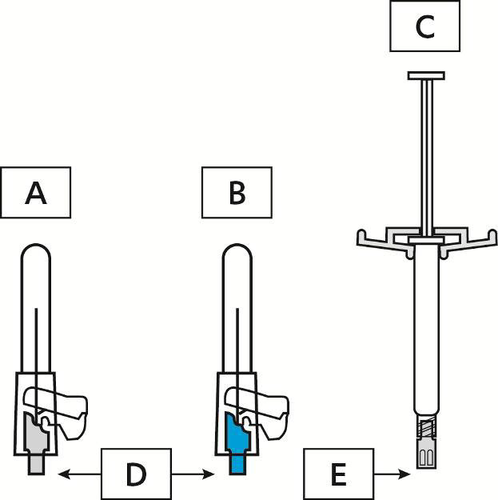
- (A) 22 G x 1.5 inch (gray nozzle)
- (B) 23 G x 1 inch (blue nozzle)
- (C) Pre-filled syringe
- (D) Nozzle
- (E) End cap
- 1. Shake the pre-filled syringe vigorously for at least 10 seconds to ensure the suspension is homogeneous.
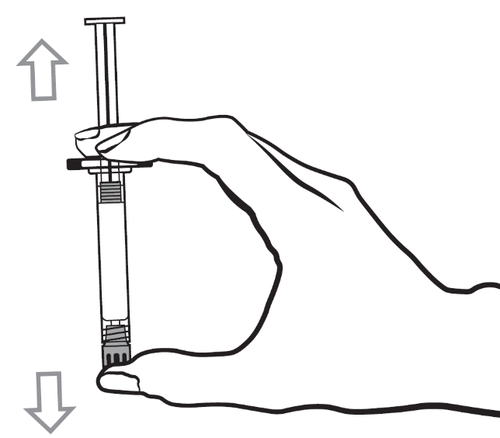
- 2. Choose the appropriate needle.
The first initiating dose of Palifren Long (150 mg) should be administered on
- 1. day 1 of treatment into the DELTOID MUSCLE using the DELTOID MUSCLE needle. The second initiating dose of Palifren Long (100 mg) should be administered 1 week later (day 8) into the DELTOID MUSCLE using the DELTOID MUSCLE needle.
In case of a switch from risperidone long-acting injections to Palifren Long, the first injection of Palifren Long (in a dose of 25 mg to 150 mg) can be administered into the DELTOID MUSCLE or GLUTEAL MUSCLE using the appropriate needle on the day of the next scheduled injection. Subsequently, monthly maintenance doses can be administered into the DELTOID MUSCLE or GLUTEAL MUSCLE using the appropriate needle.
For injections into the DELTOID MUSCLE in patients with a body weight <90 kg, the 1 inch, 23 g (25.4 mm x 0.64 mm) needle (needle with blue nozzle) should be used. if patient's body weight is ≥90 1.5 22 (38.1 0.72 gray used.
For injections into the GLUTEAL MUSCLE, the 1.5 inch, 22 G (38.1 mm x 0.72 mm) needle (needle with gray nozzle) should be used.
- 3. Hold the pre-filled syringe vertically and remove the rubber end cap by a twisting motion.
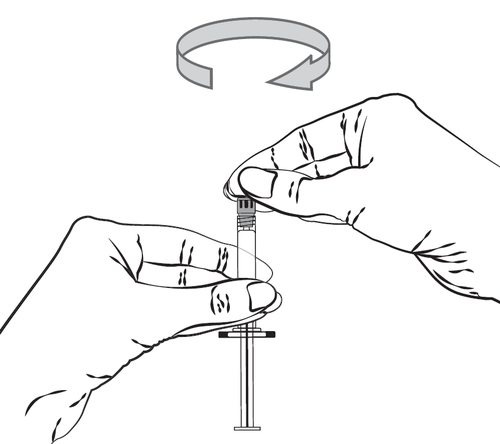
- 4. Tear the outer part of the needle package in half. Grasp the needle shield by the plastic needle shield. Connect the Luer lock of the needle shield to the pre-filled syringe by a gentle twisting motion in the direction of the arrow.
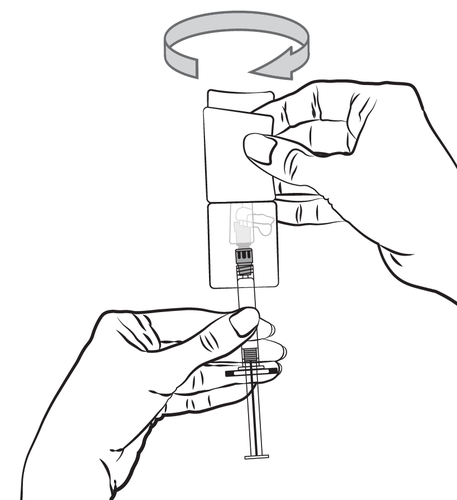
- 5. Pull the needle shield straight off the needle. Do not twist the needle shield, as this may cause the needle to loosen from the pre-filled syringe.

- 6. Remove any air from the pre-filled syringe by gently pressing the plunger while holding the pre-filled syringe in an upright position.
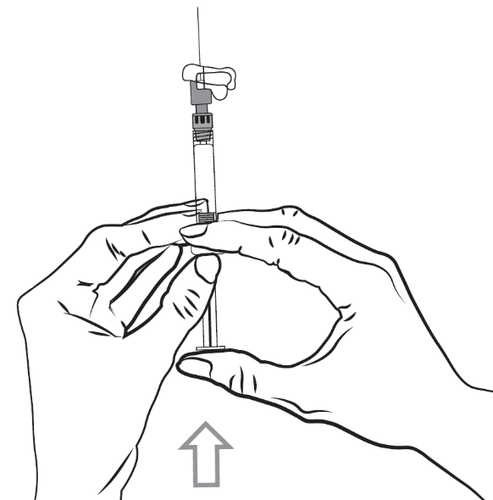
- 7. Inject the entire contents of the pre-filled syringe intramuscularly, slowly, and deeply into the selected muscle of the patient — deltoid or gluteal. Do not administer the product intravenously or subcutaneously.
- 8. After the injection is complete, secure the needle with the thumb or finger of one hand (8a, 8b) or a flat surface (8c). The click sound confirms the needle is properly secured. Dispose of the pre-filled syringe with the needle in an appropriate manner.
8a

8b
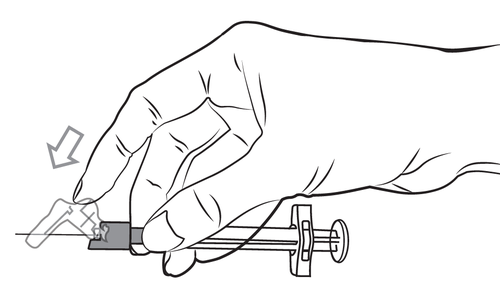
8c

- Country of registration
- Active substance
- Prescription requiredYes
- Manufacturer
- ImporterAdamed Pharma S.A. Pharmathen International S.A. Pharmathen S.A.
- This information is for reference only and does not constitute medical advice. Always consult a licensed doctor before taking any medication. Oladoctor is not responsible for medical decisions based on this content.
- Alternatives to Palifren LongDosage form: Suspension, 25 mgActive substance: paliperidoneManufacturer: Pharmathen International S.A. Pharmathen S.A.Prescription requiredDosage form: Suspension, 50 mgActive substance: paliperidoneManufacturer: Pharmaten International S.A. Pharmaten S.A.Prescription requiredDosage form: Suspension, 75 mgActive substance: paliperidoneManufacturer: Pharmaten International S.A. Pharmaten S.A.Prescription required
Alternatives to Palifren Long in other countries
The best alternatives with the same active ingredient and therapeutic effect.
Alternative to Palifren Long in Spain
Alternative to Palifren Long in Ukraine
Online doctors for Palifren Long
Discuss dosage, side effects, interactions, contraindications, and prescription renewal for Palifren Long – subject to medical assessment and local rules.









